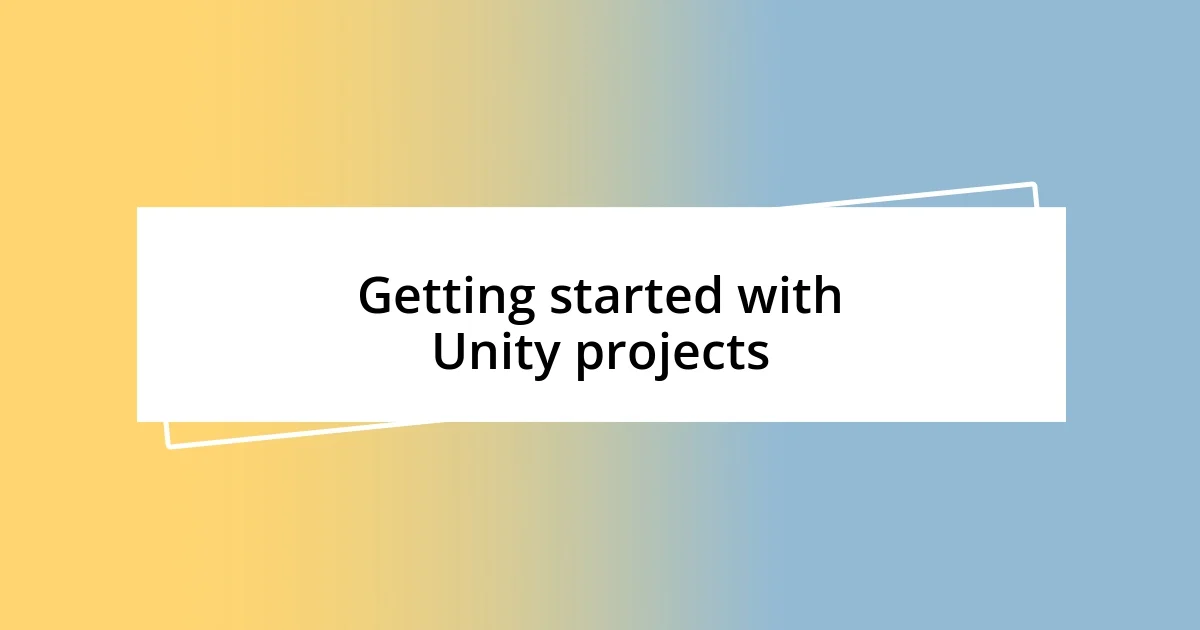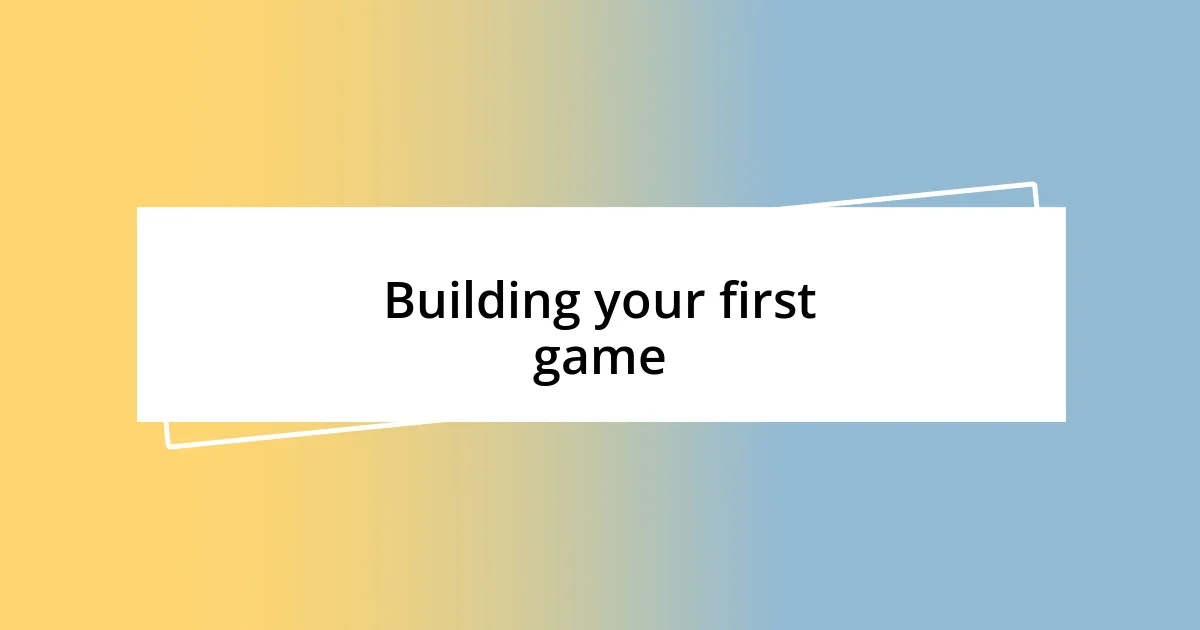Key takeaways:
- Initial interest in Unity sparked by the creativity of indie games and the joy of creating a basic platformer.
- Understanding Unity’s interface and utilizing essential tools, such as the Animator and Profiler, significantly boosts confidence and creativity in game development.
- Engaging with resources like Unity Learn, relevant books, and community forums enhances learning and problem-solving throughout the game development journey.

My initial interest in Unity
It all started when I discovered indie games. I was captivated by their creativity and the stories they told. I remember one evening, lost in a world of pixel art and immersive soundscapes, thinking, “How do they create such engaging experiences?” That curiosity led me straight to Unity.
As I delved deeper into the world of game development, my excitement grew. I recall spending late nights watching tutorials, taking notes, and experimenting with simple projects. There was a moment when I managed to create a basic platformer, and the thrill of seeing my character jump for the first time was exhilarating. Have you ever felt that rush when you build something from scratch? It’s hard to describe, but it ignited a passion in me that I hadn’t expected.
Unity felt like a treasure chest filled with endless possibilities. I could almost feel my imagination running wild—what if I could create entire universes? Each time I clicked on a new feature, I felt like an artist with a blank canvas, ready to paint my ideas into reality. That initial spark of interest blossomed into a fervent desire to learn more, and that journey still excites me today.

Understanding Unity interface
The Unity interface is a vibrant space where creativity meets functionality. When I first opened it, I was initially overwhelmed by the array of panels and options. However, exploring each section felt like a treasure map guiding me to new adventures. I vividly remember the moment I discovered the Inspector panel and understood how modifying properties could bring my game elements to life. It was like flipping a switch in my mind; I realized that every small detail I adjusted could drastically change the player’s experience.
Here are a few key components of the Unity interface that I found particularly impactful:
- Scene View: A visual representation of your game world where you can see and arrange all your objects.
- Game View: This is where you can preview your game from the player’s perspective.
- Hierarchy Panel: Displays all the objects in your scene, allowing for easy organization and access.
- Inspector Panel: Shows the properties of selected objects, giving you control over their behavior and appearance.
- Project Panel: Centralizes all your assets like scripts, models, and textures, making them easy to manage.
Once I familiarized myself with these components, my confidence soared. The interface became less of a puzzle and more of a portal to my creative aspirations. Each session spent navigating it felt like a step deeper into an exhilarating journey of discovery.

Getting started with Unity projects
Getting started with Unity projects is an exciting yet challenging venture. I remember my first project vividly; I decided to create a simple 2D game. The thrill of setting up my first scene and placing objects with just a drag-and-drop felt like magic. However, I quickly realized that simply placing objects wasn’t enough. Understanding how to use scripts to bring those objects to life was a major leap forward, and it was my first taste of coding in C#. Have you ever started something new and felt both exhilaration and a twinge of anxiety? That’s precisely how I felt, but overcoming that initial fear opened a world of creativity.
As I continued my journey, I learned the importance of planning my projects. Before diving headfirst into Unity, I found it useful to sketch my ideas or write down a game design document. This not only organized my thoughts but also provided a clear roadmap for my project. One day, I meticulously drafted a blueprint for a mini-platformer that I wanted to create, which not only made the development process smoother but also offered me a satisfying reference. I can’t emphasize enough how vital it is to have a clear vision from the start—it’s like having a compass that guides your creative decisions.
To further enhance your experience with Unity, it’s essential to familiarize yourself with the asset store. When I first discovered it, I was dazzled by the plethora of assets available. I found free starter packs and even premium assets that saved me countless hours. The vast library allowed me to focus on the creative aspects of my project rather than getting bogged down in the nitty-gritty of asset creation. Exploring such resources effectively accelerates the learning curve and makes your projects shine.
| Step | Action |
|---|---|
| 1 | Start a new project and familiarize yourself with the interface. |
| 2 | Sketch your game idea to create a clear vision. |
| 3 | Utilize the asset store for resources to enhance your project. |

Essential Unity tools and features
The Unity Editor is jam-packed with tools that can make or break your development experience. For instance, when I first encountered the Animator window, I felt like I stumbled onto a director’s studio. It was exhilarating to see how creating animation clips for my characters could add depth and dynamism to my game. Have you ever played a game and wondered how characters seem to come alive? That’s the magic beating in the Animator’s heart, giving developers the power to breathe life into pixels.
In addition to animation, the Unity Profiler became my go-to tool for optimizing performance. The first time I used it, I was amazed to visualize how different elements affected my game’s frame rate. There’s something incredibly satisfying about pinpointing those pesky bottlenecks that cause lag. I still remember a frustrating afternoon spent tweaking my game; I thought, “Why does my character jump stutter?” But with the Profiler, I could easily identify that some audio files were too large. Learning to optimize my game not only improved its performance but also taught me the value of analytics in game design.
Another feature that I found instrumental is the Physics engine. As I experimented with Rigidbody components, the thrill of tossing a block and watching how it behaved in the game world was eye-opening. I’ll never forget the moment my character accidentally sent a box flying off the screen. That first chaotic event made me realize how crucial understanding physics can be. It transforms gameplay from simple interactions into something that feels real and engaging. Isn’t it incredible how a few principles of physics can significantly elevate your game design?

Learning C# for Unity
Learning C# for Unity has been like embarking on an adventurous treasure hunt for me. I recall cracking open my first C# tutorial, feeling a mix of curiosity and skepticism. While I stumbled through the syntax in the beginning—how many times did I forget that semicolon!—I soon discovered the joy of writing meaningful scripts. It was during my first successful implementation of a player movement script that I experienced a rush of accomplishment. Don’t you love that moment when everything clicks into place?
As I progressed, object-oriented programming concepts became my best friends. I vividly remember grappling with classes and objects, often questioning their purpose. It wasn’t until I created a health system for my game that I understood their value. The ability to encapsulate properties and behaviors into reusable classes not only simplified my code but also made it far more manageable. Reflecting on that experience, I realize how essential it is to grasp these fundamental concepts—they form the backbone of efficient coding.
Debugging C# scripts turned out to be another vital lesson in my journey. Early on, I often found myself frustrated with inexplicable errors. I can recall the sheer relief of finally tracking down a missing bracket that had thwarted my progress for days. Each debugging session taught me patience and analytical thinking, skills that are invaluable in development. So, have you ever felt lost in a sea of code? Remember, every failure is a stepping stone to mastery, and the learning never truly stops.

Building your first game
Building your first game in Unity feels like stepping into a new world of creativity. I vividly remember the excitement of dragging my first GameObject onto the scene and watching it come to life. I was nervous—would I mess it up? But as I tinkered with basic components like sprites and colliders, it dawned on me that this was my playground. Isn’t it thrilling to know that every click could lead to something extraordinary?
When I decided to integrate sound into my game, the experience was nothing short of magical. I went from silence to having a soundtrack that matched my game’s mood perfectly. I still chuckle thinking about the moment I uploaded the wrong sound effect and ended up with a quirky, comic sound when my character took a simple action. That unexpected laughter taught me an invaluable lesson: sometimes, the unplanned surprises become the most memorable moments in game development.
Finally, I must emphasize the importance of iterations. My initial game was quite basic, but with each playtest, I found areas for improvement. I can recall the impatience after my first round of feedback—it stung to hear what was wrong. But then I realized: every piece of feedback was a stepping stone. I iterated on ideas, tried new mechanics, and, before I knew it, I was creating a vastly improved version. Have you experienced a similar transformation in your projects? The growth you achieve is part of what makes this journey so rewarding.

Resources for further learning
When it comes to diving deeper into Unity, there are some invaluable resources that I found particularly effective. One of my favorites is the official Unity Learn platform. It’s packed with tutorials that cater to various skill levels. I remember spending countless hours there, immersing myself in interactive lessons that challenged my understanding and pushed my creativity. Have you explored it yet? If not, I highly recommend taking a look!
Books can also be a fantastic source of knowledge. One title that truly resonated with me was “Unity in Action” by Joe Raedle. The practical examples and detailed explanations helped clarify concepts I struggled with early on. I’ll never forget the ‘aha’ moment I had while reading about physics in Unity—I applied it directly to my project and saw immediate results. It’s amazing how a single book can shape your journey, don’t you think?
Finally, joining communities can make a world of difference. Engaging with fellow learners on forums like Unity’s own community page or Reddit can be a treasure trove of tips and advice. I still remember the time I posted a question about optimizing my game’s performance and received a flood of insightful responses. The support and camaraderie found in these spaces can provide encouragement when you hit those inevitable roadblocks. Have you ever leaned on a community for support? It’s a valuable resource that can inspire growth in unpredictable ways.














